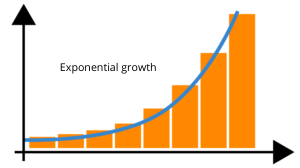Compounding calculator
Compounding interest is kind of a snowball effect. Since you are getting a return/yield on the previuos years returns your investment will grow exponential.
Results - compounding
End value
Amount in returns
Saved amount
How it Works – Interest on interest
Many recognize the term interest-on-interest or compund interest as something generally good, but you may not understand exactly what it means. Or maybe you just haven’t thought about how to benefit from it. So what does it mean, interest on interest, and what is the simplest way to understand the principle of it?
One good way to understand interest on interest is to imagine a rolling snowball. The snowball gets bigger and more snow gets stuck. This leads to the snowball increasing in size at a faster rate. In the beginning, it grows very slowly, but with time, the size increases much faster.
Interest on interest works the same way. Imagine the return/interest you get from your savings account every year. The year after that you save just as much money, and will again receive interest, but now on a higher total amount since last year’s interest is added to your savings. To put it simply: You get interest on your savings AND last year’s interest, i.e. interest on interest.
Here is an example of how interest on interest develops in numbers:
Let’s assume you save USD 100 every month, which means you save USD 1,200 per year. You estimate your interest to be 8 percent on average per year. Your savings will develop in the following way:
Year 0: 1,200
Year 1: 2,496 = 1,200 + (1,200 ⋅ 1,08).
1,200 is added to the savings account. The savings from year 0 generated 8 % interest, or USD 96.
Year 2: 3,895 = 1,200 + (2,496 ⋅ 1,08)
1,200 is added to the savings account. Interest is generated on the savings from previous years plus the interest generated in year 1.
Year 3: 5,407 = 1,200 + (3,895 ⋅ 1,08)
1,200 is added to the savings account. Interest is generated in all previous years, including interest already generated. The money from year 0 now has earned 8 % interest for three years, year 1 for two years, and year 2 for one year.
You can see now how it all adds up in the long run. The longer the money can sit and collect interest, the higher the reward will be. Of course in your bank account, you only see the total amount at any given time, but hopefully, this example makes the logic behind interest on interest more comprehensible. In mathematics, this is called a geometric progression – more on that later.
What affects your return?
There are many different factors that may affect the return of your savings. Some of those factors are:
- Interest or expected return – If you have your savings in an interest fund or a normal bank account, the interest is most likely set beforehand and/or easy to predict. It tends to get a bit more complicated when saving in shares or equity funds. This is because the return in shares and equity funds can fluctuate. A rule of thumb to follow when calculating interest is to remember that the stock market on average increases by 11 % each year.
- Amount of money in your savings account – In order to make maximum profit of interest-on-interest it is important to deposit money regularly to the savings account. This ensures that you generate as much interest as possible.
- Time – You are going to make more money as time goes by. In the beginning, the return may feel a bit weak, but with time the exponential growth will show its results.
Feel free to put in your own numbers in the example above to calculate your own interest-on-interest potential.
The math behind the compounding effect
In order to correctly calculate interest on interest, you can use a geometric series formula. Geometric progression is a progression where the next number is calculated by multiplying the number with a certain quota – in this case, the interest. 8 % interest means you should multiply the number by 1.08.
Geometric progression is calculated by using the following formula:
an = a1 ⋅ k^(n-1)
an is the total sum you want to calculate.
- a1 is the amount you deposit to your savings account every year.
- k is the interest rate (1.08 for 8 % interest)
- n is the number of years you want to save.
The effect of interest on interest is often called exponential growth or exponential increase. To summarize, it means that the more money you save the more money you will generate from the interest.
